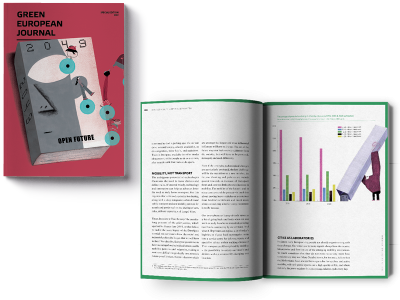In order to grasp the future, sometimes it is necessary to speak from the future itself. Not from a future as something given or destined, but from a future understood as a possibility, a potentiality, which could or could not happen, depending on what we do in the present.
Back in the late 2010s, only 30 years ago, when walls and borders were already becoming the prevailing backdrop to Europe’s decline, a report published by the World Bank projected that 55 per cent of the developing world’s population was at risk from climate change.[1] Over 140 million people were forecasted to migrate by 2050.
The World Bank estimated that climate change would lead to crop failures, freshwater scarcity, and sea-level rises. Millions from three of the world’s major regions – Sub-Saharan Africa (from Sudan and West Africa to the Cape of Good Hope), Central and South America (from Mexico to the Strait of Magellan), and South Asia (Afghanistan, Pakistan, India, Nepal, Bhutan, and Bangladesh) – were to be forced into ‘in and out’ migration.

According to the report, the year 2050 was a tipping point beyond which climate change migration would accelerate in the absence of significant cuts to greenhouse gas emissions and green investment. “Without the right planning and support, people migrating from rural areas into cities could be facing new and even more dangerous risks,” said the report’s lead author, Kanta Kumari Rigaud. “We could see increased tensions and conflict as a result of pressure on scarce resources. But that doesn’t have to be the future. While internal climate migration is becoming a reality, it won’t be a crisis if we plan for it now.”
Back in the past, scientists were warning not only of unprecedented migration due to climate change, but also of mass extinction. As early as 2006, when the world was already facing major geopolitical re-alignment, natural disasters, heatwaves, ice melting, militarisation, migration crises, and rising populist and authoritarian regimes, a new study by an international team of ecologists and economists predicted the new date of the Apocalypse: 2048.[2] The date when the world’s oceans would be empty of fish. The cause: the disappearance of species due to overfishing, pollution, habitat loss, and climate change.
And here we are, it is 2049. While the sea-level rises devastate and empty vast territories of the world, forcing hundreds of millions to flee to Europe, we who are the Nachgeborenen (the ‘born-after’, German poet and playwright Bertolt Brecht’s beautiful term from his Svendborger Gedichte collection, written in his Danish exile in 1939, about those who will follow after the disaster of the Second World War) sit and have dinner, although there are no fish at the table any more. The food we eat is already polluted by microplastics, found everywhere from the high Swiss mountains to the Antarctic. As a result of tremendous climate change, with devastating consequences not only for humans but the whole ecosystem, the response of governments – which in 2019 were convincing their populations that the only solution to the world’s crisis was to build walls from Mexico to Hungary, from Brazil to Morocco – was a desperate and inhuman response from the past.
Instead of opening itself to planetary thinking, instead of seizing the future by using the latest technological advances and the historical opportunity of humanity to transform itself into a truly global community, the political and business elites of 2019 were leading the world straight towards its worst dystopian predictions. We were not sleepwalking into this abyss, we were walking into it with all the facts in front of us. Mass extinction. Rising sea levels. Migration. Wars and planetary devastation.
While most of Europe was on the brink of occupation and stuck in a totalitarian nightmare, Brecht asked in Die Nachgeborenen back in 1939 whether, in such circumstances, we can have “conversations about trees”, and how we can eat and drink when others starve and those who are thirsty do not have our glass of water? And yet we eat and drink. “He who laughs,” writes Brecht, “has not yet received the terrible news.”
In 2019, we were drinking and eating, while having a conversation about trees was once again becoming a crime because so many were being cut down and so many desperate refugees were hiding in the woods. We the Nachgeborenen, the ones born after the atrocities of the First and Second World Wars, were, again, eating and drinking while historical and planetary events were leading humanity – and this time, the planet itself – into an abyss, a point of no return.
To escape the current of “the slow cancellation of the future”,[3] we need what the French engineer and philosopher Jean-Pierre Dupuy, best known for his work on catastrophism, calls “enlightened doomsaying”.[4] Dupuy argues that what might seem impossible – a global-scale ecological catastrophe, for instance, or an Armageddon-inducing nuclear war – is nonetheless, based on our present knowledge, inevitable. Assuming that one of these catastrophes is our destiny (the dystopian Year 2049), there is something we can do. We can retroactively change the conditions of possibility out of which this destiny will come.
[1] Kanta Kumari Rigaud et al. (2018). Groundswell: Preparing for Internal Climate Migration. Washington, DC: World Bank. Available at <http://bit.ly/2MNwYRe>.
[2] Daniel DeNoon (3 November 2006). Salt-Water Fish Extinction Seen By 2048. CBS News. Available at <http://cbsn.ws/2FMZT4D>
[3] Franco Berardi (2011). After the Future. Chicago: AK Press.
[4] Jean-Pierre Dupuy (2004). Pour un catastrophisme éclairé: quand l’impossible est certain. Paris: Seuil.

